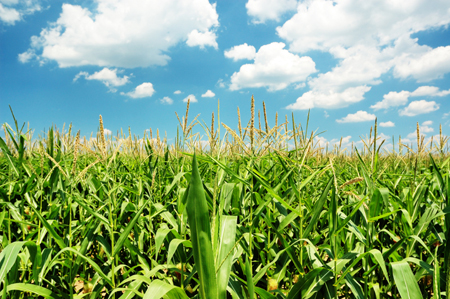Corn Crowned King in 2011 Crop Yield
Category: Grains
 Despite see-saw weather conditions of torrential drought and massive flooding, U.S. farmers will still produce the third largest corn crop in history. However, soybeans, cotton and wheat production will likely falter.
Despite see-saw weather conditions of torrential drought and massive flooding, U.S. farmers will still produce the third largest corn crop in history. However, soybeans, cotton and wheat production will likely falter.
According to the USDA’s August 11, 2011 crop production report, July’s absurdly high temperatures and little to no rainfall rapidly increased crop maturation while negatively impacting soil moisture levels and stressing crops. In several portions of the Great Plains, monthly temperatures reached an average of 10 degrees higher than normal temperatures.
California and Texas received less than 25 percent of normal precipitation, while portions of the Great Lakes, Great Plains and Gulf Cost accumulated only six or more inches of rainfall during the month.
Analysts predict corn to be the saving grace of the food commodity industry this year, producing 12.9 billion bushels, up four percent from 2010. As of August 1, the projected national average yield was pegged at 153.0 bushel per acre, up 0.2 bushels per acres from 2010, making it the fourth highest yield on record.
On the other hand, soyDespite see-saw weather conditions of torrential drought and massive flooding, U.S. farmers will still produce the third largest corn crop in history. However, soybeans, cotton and wheat production will likely falter.
According to the USDA’s August 11, 2011 crop production report, July’s absurdly high temperatures and little to no rainfall rapidly increased crop maturation while negatively impacting soil moisture levels and stressing crops. In several portions of the Great Plains, monthly temperatures reached an average of 10 degrees higher than normal temperatures.
California and Texas received less than 25 percent of normal precipitation, while portions of the Great Lakes, Great Plains and Gulf Cost accumulated only six or more inches of rainfall during the month.
Analysts predict corn to be the saving grace of the food commodity industry this year, producing 12.9 billion bushels, up four percent from 2010. As of August 1, the projected national average yield was pegged at 153.0 bushel per acre, up 0.2 bushels per acres from 2010, making it the fourth highest yield on record.
On the other hand, soybean production will stagger in at a forecasted 3.06 billion bushels, down eight percent from last year. Based on conditions in the same timeframe, yields will average 41.4 bushels per acre, down 2.1 bushels from last year.
All wheat production fell one percent from July’s forecast and dropped six percent from 2010. Based on August 1 conditions, analysts predict wheat will produce 45.2 bushels per acre, up 0.6 bushels from July, but down 1.2 from the previous year.
The USDA forecast indicates another resilient harvest for U.S. farmers. J.P. Morgan analyst Ann Duignan estimated the new outlook adds another $5 billion to U.S. farm cash receipts for the upcoming crop year.bean production will stagger in at a forecasted 3.06 billion bushels, down eight percent from last year. Based on conditions in the same timeframe, yields will average 41.4 bushels per acre, down 2.1 bushels from last year.
All wheat production fell one percent from July’s forecast and dropped six percent from 2010. Based on August 1 conditions, analysts predict wheat will produce 45.2 bushels per acre, up 0.6 bushels from July, but down 1.2 from the previous year.
The USDA forecast indicates another resilient harvest for U.S. farmers. J.P. Morgan analyst Ann Duignan estimated the new outlook adds another $5 billion to U.S. farm cash receipts for the upcoming crop year.




